31. Today in 1920s Turkey: 12 November 1923 (The Chester Concession)
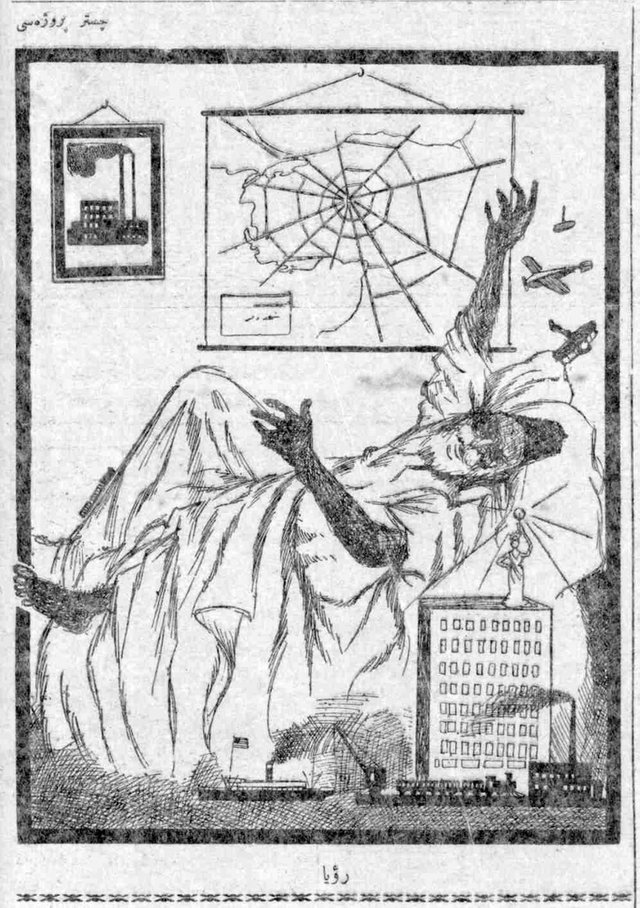
(“Dream,” Akbaba, 12 November 1923, no. 98, page 2.)
Today’s installment of “Today in 1920s Turkey” differs from previous posts in that several related images will be discussed at once. Up for consideration are three cartoons from the Monday, 12 November 1923 issue of Akbaba (no. 98) each featured on a different page. The first two cartoons are sequential and represent an “illusion” (page 2) versus “reality” (page 3). The final cartoon (page 4), as will become evident, is the inspiration for the former two.
Entitled “Dream” or “Rüya” the above cartoon from Akbaba features a flailing old man experiencing a rather lucid dream. In order to afford the reader access to this dream, rather than creating a “dream cloud” to convey the content of the man’s vision, the cartoonist has chosen to project the imaginary world of the slumbering man’s dream into the composition and place said dreamer within this fictional scene. As such, common trappings of modern, industrialized economies surround this unconscious man. On the floor is a ship bearing an American flag pulling up to a port. Accented with a skyscraper—upon which stands an incongruous Statue of Liberty-esque monument—the docks are fully equipped with an industrial crane, a generic factory, and a train to transport goods to and from the ship. Incidentally, a second train can be seen working its way up the old man’s right shin toward his knee. Other modern inventions such as airplanes fly about the “airspace” above the old man’s head. Finally, on the wall above the bed hangs a map of Turkey that explicitly renders several thousand miles of railroad connecting every inch of the country’s lands and a picture of a factory with active smokestacks.
This “dream of modernity” is sandwiched between the text above, which reads “The Chester Project,” and the word “Dream” featured below. The Chester Project was an absurd concession negotiated between a syndicate of American companies and investors and the Turkish government in 1923. According to this project, in return for building railroads across Turkey the conglomerate would gain tax exempt status and have the rights to mine for minerals and oil within a generous 20 kilometer radius of every inch of railroad laid in the country for the next 99 years (in addition to other perks). Thankfully, the plan was scrapped by the Turkish government by the end of 1923. The plan was initially favored because it guaranteed rapid industrial development for the nascent nation-state emerging from the ashes of the defunct Ottoman Empire in the wake of World War I. The project’s promise, which required no capital investment on the part of the Turkish government, is what is illustrated in the dream world of the above cartoon. This project, which reeks of privatized, shameless colonialism, was received with mixed feelings by the Turkish media. The following cartoon indicates disappointment on behalf of the cartoonist (or entire staff of Akbaba) in response to news suggesting the deal is falling through.
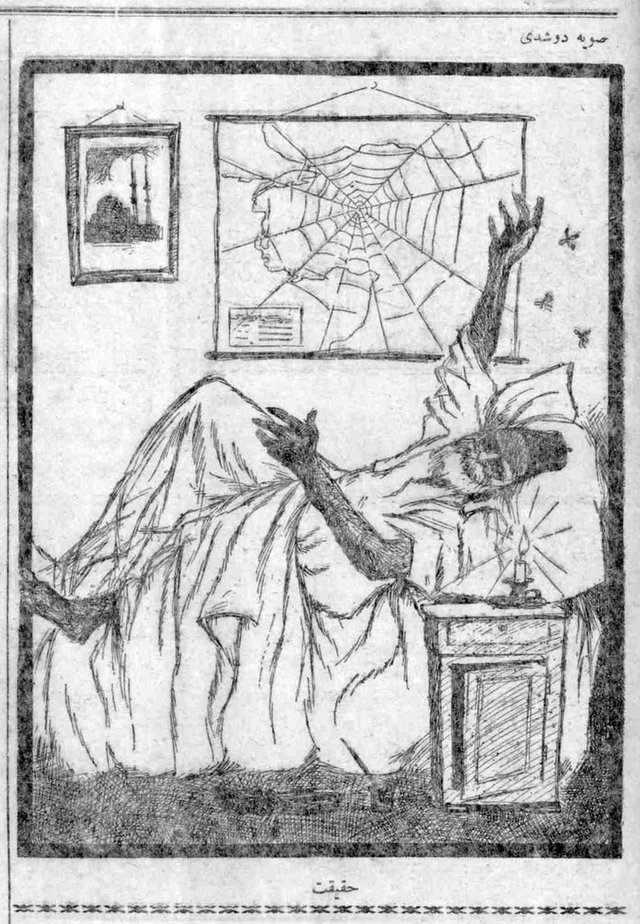
(“Reality,” Akbaba, 12 November 1923, no. 98, Page 3.)
This second cartoon featured on page 3 of the same issue of Akbaba mimics the first cartoon in composition but with several key differences. Once again, at the center of the picture is an old man asleep and thrashing about in bed. Instead of the modern technological wonders of boats, trains, cranes, and skyscrapers next to his bed he has a small rickety table with nothing but a candle on it (this is meant to contrast with the electrically lit torch held by the Statue of Liberty in the previous cartoon). Instead of airplanes flying above the man’s head there are pesky flies occupying the skies. Turning to the map on the wall above the old man’s bed, instead of railroads cross-crossing the territories of Turkey there are cobwebs—a sign of ruin and demise—superimposed on the country. The other picture on the wall is that of a mosque instead of a factory. Here, the mosque’s minarets replace the smokestacks of the previous cartoon’s framed picture of a factory.
The words “Fell Through” or “Suya Düştü” appear above the cartoon and “Reality” or “Hakikat” is below it. Unable to foresee the negative consequences of this deal, the cartoonist claims that this is the fate of Turkey without the help of the Chester Project.
Finally, on the last page of this issue of Akbaba the reader is provided with the inspiration for this cartoon in a republished German cartoon. It was not uncommon for Akbaba to feature translated cartoons from European or American newspapers on its back cover. The two adjacent frames below constitute the source of the Chester Project cartoons.
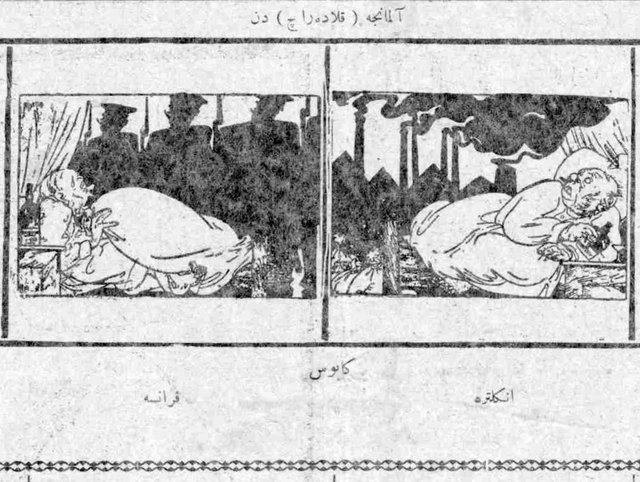
(German cartoon, Akbaba, 12 November 1923, no. 98, page 4.)
Much like the Turkish cartoons, there are two frames and a sleeping man’s dreams projected out into his surroundings. Whereas the dreaming “Turk” was the same man in both cartoons, here the man on the right is identified by the text below as a personification of “England” and the man on the left as “France” and both of them are equally haunted by their respective nightmares. Indeed, the shared caption for both frames is “Nightmare” or “Kabus.” Looking to the imagery it is evident that England is afraid of industry and France afraid of war. What kind of current events sparked this interpretation by the original German artist is outside of my field of expertise. There are both significant parallels and differences between the two way in which these nightmares have been conveyed. The Turkish cartoonist did not merely change the words and a few details in the cartoon to adapt it to a Turkish news story. Launching from this origin cartoon he takes the two-part layout completely re-conceptualized their narrative purpose. Rather than telling the story of two countries he used two dual frame composition to evoke an [unrealized] future followed by an unattractive present specific to the Turkish experience. Like the German cartoonist, the Turkish artist limits his use of text.
Find below images of each full page discussed in this post.
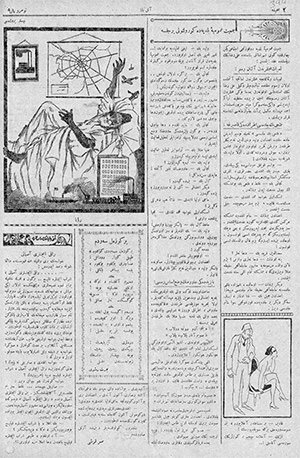
(Entire page, Akbaba, 12 November 1923, no. 98, page 2.)
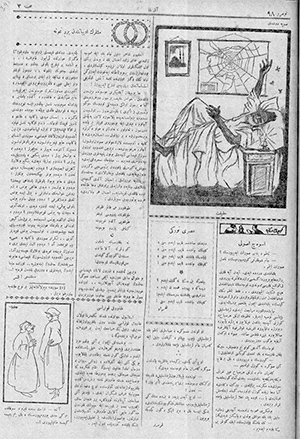
(Entire page, Akbaba, 12 November 1923, no. 98, page 3.)

(Entire page, Akbaba, 12 November 1923, no. 98, page 4.)
nice content started following u :D Please see my blog and follow back if u want :)
Thanks! I'll check it out!